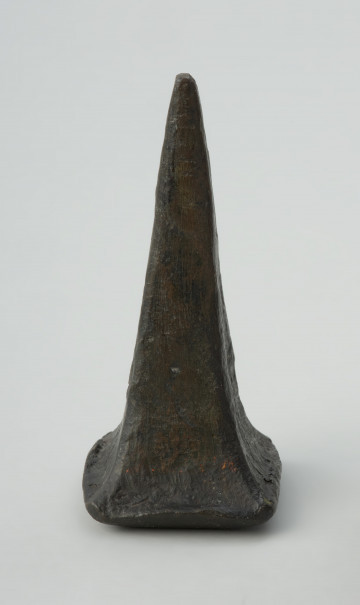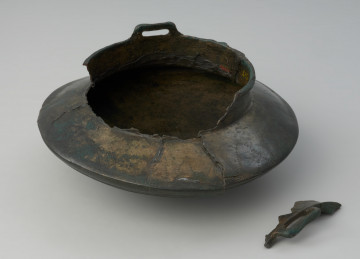
A bronze anvil
around 900 p.n.e. — 750 p.n.e.
National Museum in Szczecin
Part of the collection: Middle Ages
A silver, two-cone bead, made of two interconnected triangular plates with rounded tops, decorated with filigree particles, was found in Bogucino, in the Kołobrzeg poviat. It was part of a treasure hoard carrying two more beads of this type, alongside other pieces of jewellery and coins, which were placed in a clay vessel buried under a large stone. The time at which all cluster finds were deposited in the ground is dated after 995. Silver used in the Slavic region was mostly imported. A small portion was also extracted from indigenous lead or copper ores. Initially, raw silver arrived from the Arab lands by way of coins, which were melted down to be later used for the production of ornaments. The earliest local makers used simple goldsmithing methods, such as forging, casting or wire moulding, as evidenced by the oldest finds of this class of artifacts. Production techniques were developed through their own practice, but above all via connections with other European goldsmiths. This is particularly prominent in products from the 10th to the 11th centuries, when high-quality decorative techniques such as filigree, which is the making of ornaments with fine wires, and granulation, which involves decorating with tiny balls, became widely used. The application of new techniques and the evolution of the skills of local goldsmiths also resulted in a greater range of forms applied to the objects produced. Ewa Górkiewicz-Bucka
Author / creator
Object type
bead, adornment
Technique
forging, granulation, cutting, welding
Material
silver
Origin / acquisition method
legal transfer
Creation time / dating
Creation / finding place
Owner
Muzeum Narodowe w Szczecinie
Identification number
Location / status

around 900 p.n.e. — 750 p.n.e.
National Museum in Szczecin

around 600 p.n.e. — 400 p.n.e.
National Museum in Szczecin

around 900 p.n.e. — 750 p.n.e.
National Museum in Szczecin
DISCOVER this TOPIC
National Museum in Lublin
DISCOVER this PATH
Educational path